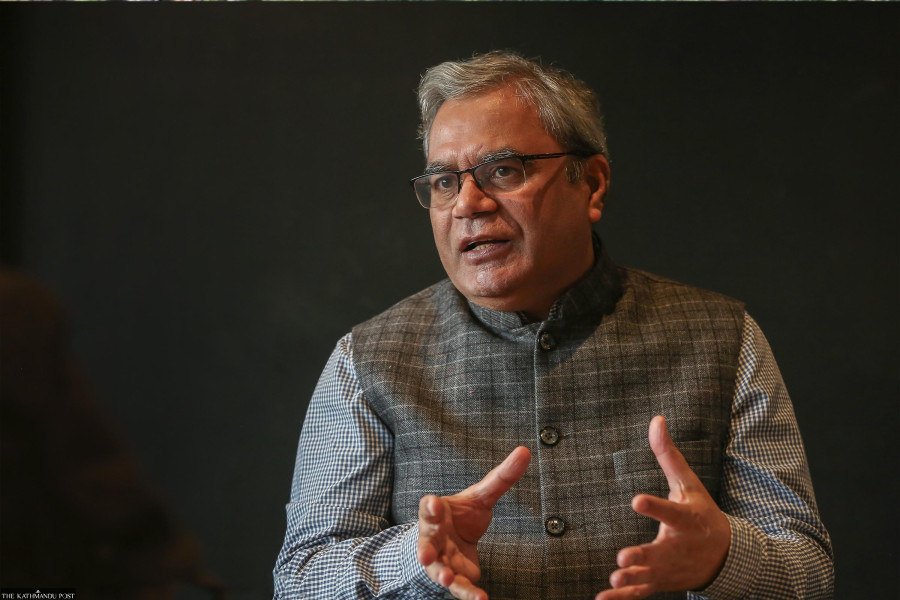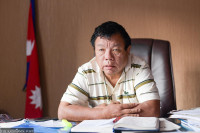Interviews
Member states common to Saarc and Bimstec will benefit from both
There are a number of concrete proposals to enhance cooperation in different areas and to remove institutional shortcomings.
Anil Giri
Indian career diplomat Indra Mani Pandey has been serving as the secretary general of the Bay of Bengal Initiative for Multi-Sectoral Technical and Economic Cooperation (Bimstec) since October 2023. He was recently in Nepal in order to lay the ground for the next Bimstec summit scheduled in Bangkok, Thailand for April 2025. The Post’s Anil Giri caught up with Pandey in Kathmandu in order to get his views on the role of Bimstec, its evolution and Nepal’s place in it.
To begin with, what were the objectives of your most recent Nepal visit?
We are going to have the sixth Bimstec Summit soon and I felt like visiting Nepal to interact with government officials. Also, when I had an interaction with Arzu Rana Deuba, Foreign Minister of Nepal, in New York on the sidelines of the Bimstec Foreign Ministers meeting in September 2024, she had invited me to visit Kathmandu. So the purpose of my visit is to have an opportunity to interact with the new Nepali foreign secretary as well as with the ministers responsible for other ministries which have been making direct contributions to Bimstec. For example, I met the Minister for tourism, culture and civil aviation and also the Minister for industry, commerce and supplies.
How in your view can Nepal benefit from Bimstec?
Bimstec may not be very well known here, at least not as well as the Saarc. But it does not mean Bimstec has not been contributing to the development of the member states. The organisation has been in existence for 27 years.
Nepal joined in 2004, six years after the inception of the organisation. I think when we engage in regional cooperation through Bimstec, it’s with an understanding that it will be in the interest of all member states. The vast agenda of the organisation has been defined by all member states and all member states benefit equally from the activities of the organisation.
So, like any other member state, Nepal has been a beneficiary. Nepal has also been playing a significant role in the inception of the agenda of Bimstec and in the creation of its institutional mechanisms. Let me bring to your attention the summit of the Bimstec leaders Nepal had hosted in 2018. At that summit, the idea of negotiating and finalising a charter was discussed. Even the idea of reorganising the sectors of cooperation under seven pillars so that each member state could be made responsible for one pillar had been discussed. Yes, that was something which had come out of the Kathmandu summit.
But beyond the summits too, Nepal has been an enthusiastic participant in all the meetings and activities of Bimstec. In 2024, Nepal took the initiative to convene some meetings which had not taken place for long. For example, the meeting of the expert group on cultural corporation, the meeting of the working group on tourism, the meeting of the working group on poverty alleviation and most importantly, the meeting of the expert group on visa matters. So Nepal made a significant contribution and it has in fact offered to host some ministerial meetings in 2025 as an active participant and contributor to the Bimstec process.
I think Nepal has moved forward with the belief that more regional cooperation through Bimstec will be as much in its interest as of any other member.
But wouldn’t you agree that the progress of Bimstec as an organisation has been rather slow. Just like Saarc, the organisation seems to be stagnating. What is the problem?
I think there has been progress in forging institutional mechanisms for cooperation in different sectors. Member states have agreed on action plans in these sectors. In some sectors, there are also master plans.
If we look at the realisation of Sustainable Development Goals, we find that our member states have lagged behind. So there is a lot that needs to be done. And you are right in saying that the Bimstec would have accomplished more. Yet I also think the future of Bimstec is filled with optimism.
There are many reasons for this. One, member states have agreed for more frequent summits and ministerial meetings. They also agree on the need to have institutions on the ground. So there are a number of concrete proposals to enhance cooperation in different areas and to remove institutional shortcomings related to decision making, to convening of meetings, and to approvals of different decisions. An expert Eminent Persons Group was constituted. The group submitted its report three months ago.
We’re likely to adopt that report at the next summit of leaders in Bangkok. Once we implement those recommendations, Bimstec will have overcome some institutional shortcomings which impeded regional cooperation. I believe we are at a turning point. We are poised to play a much greater role in forging regional cooperation and will continue to contribute to the member states’ goal of realising sustainable development. That is something all the member States are committed to.
There are old apprehensions that India favours Bimstec over Saarc. How do you see this? Do the two organisations complement each other or are they competitors?
If we look at the start of Bimstec, it came into being in 1997, at a time Saarc was making swift progress in forging regional cooperation.
I think the idea behind Bimstec was to bring South Asia and Southeast Asia together. Initially Thailand, Sri Lanka, Bangladesh and India came together because it was felt that there is a huge opportunity for countries around the Bay of Bengal to work together and enhance cooperation. Myanmar joined six months later. The organisation was never seen as either a rival or substitute for Saarc.
It was supposed to have its own agenda and its own way of functioning, which was to focus on technical and economic cooperation in the sectors member states had identified for themselves. Bhutan and Nepal decided to join in 2004. They felt that while Saarc was going ahead with engaging in boosting regional cooperation among South Asian countries, there was a value added by Bimstec. So Bimstec should not be seen in the context of any other regional organisation.
It should be viewed as a sub-regional or regional organisation with its own agenda, membership, vision and goals for regional cooperation. Now our member states, both in South Asia and Southeast Asia, face huge developmental challenges. I mentioned earlier that we have lagged in achieving SDGs. So there is a scope for regional cooperation and such regional cooperation can be pursued through different organisations and they can each help their member states realise development goals.

I think the member states which are common to Saarc and Bimstec will benefit from both. In fact, some of our member states are also members of other regional organisations. Thailand and Myanmar, two Bimstec members, are part of ASEAN. Four Bimstec members are also members of the Indian Ocean Rim Association. So it is not uncommon for a country to be a member of a number of regional organisations or even global organisations. Some Bimstec countries are also members of G20, some of Brics and some of the Shanghai Cooperation Organisation.
Saarc is in a moribund state. Even Bimstec has its problems, for instance Myanmar may not attend the upcoming Bimstec summit. Idea of cooperation in this region of the world seems to be challenging. Would you agree?
I would refrain from commenting on Saarc. But my experience with Bimstec has been that all member states are committed to continuing regional cooperation despite the political developments or government changes in individual countries. This is why its future is bright.
I would like to assure your readers that Bimstec, after implementing the recommendations of Eminent Persons Group, will be a reformed organisation, a revitalised organisation, and will be poised to play a very meaningful and fruitful role in regional cooperation. We have a number of proposals to set up centres of excellence within our region under different areas of cooperation.
We have concrete proposals on people to people contacts, in connectivity, in agriculture, in tourism and cultural cooperation. So with all those commitments from member states, Bimstec will continue to serve its purpose.
You talked about the suggestions from the EPG. But rather than lack of plans and programmes, the problem with Bimstec over the years has been one of implementation. How will you implement the EGP report?
Within eight months of their convening the first meeting in January 2024, they had submitted their final report by mid-september 2024. They evaluated the organisation structure, sectoral mechanisms of cooperation, and the core mechanisms. They analysed and detailed impediments in forging cooperation. They even compared the agenda of Bimstec with the Sustainable Development Goals approved by the United Nations. And they analysed how Bimstec has been trying to enhance cooperation in achieving those goals.
The report has been with the member states for almost four months. Member states are due to meet later this month in order to identify the ways in which the report can be implemented. Without going into the details of the recommendations, I would like to say that it makes concrete recommendations on addressing the challenges faced by Bimstec.
That is why I say the future of Bimstec is bright, which is based on my assumption that the member states are committed to implement those recommendations.
Does Bimstec also have a security or strategic dimension to cooperation among member states?
Security is just one agenda item. All other agenda items are dedicated to the SDGs of member states. Even in discussing security, focus has been on addressing those issues which have negative impact on the security of member states, for example, drug trafficking, transnational crimes, terrorism, and human trafficking. So the effort has been to address challenges member states face because development and security go hand in hand and some internal security challenges of the member states have an impact on their development.
That is why if countries around the Bay of Bengal are in a better position to address challenges to their security, it will only contribute to their development.

The next Bimstec summit is scheduled for April in Bangkok. What will be its agendas and outcomes?
One, the summit will adopt for the first time a vision for Bimstec. It will be called Bangkok Vision 2030.
The summit will also adopt rules of procedure for Bimstec, which, as I mentioned, can be traced back to the summit Nepal hosted in 2018. It will also have an agreement on maritime transport cooperation. We will sign memorandums of association with the World Bank, the UN Office on Drug and Crime and with the Indian Ocean Rim Association. And of course, the report of the EPG will be put before the member states.
More importantly, when leaders meet, they are able to reinforce each other’s vision for regional cooperation. If we look at the summits, all our summits have led to significant initiatives by member states. At the Bangkok Summit, Bangladesh will assume the leadership of Bimstec. Bangladesh will have an opportunity to play a significant role in taking the corporation forward. So, we are hopeful that apart from the regular agenda, the meeting of the leaders would lead to new ideas and new directions for the organisation.
Again, if we look at the history of Bimstec, our summits have led to enhancing the avenues of cooperation, and this summit will play a similar role. Our charter envisages that summits would be held every two years, that sectoral ministerial meetings would take place regularly. I think the more our leaders, our ministers meet, the more momentum there will be for regional cooperation.
When the seven countries sit together, their leaders are aware of their national interest and how that national interest will be served through regional cooperation. That is the occasion when the relevance of the Bimstec gets reinforced by our leaders and new directives are given for the member states to work together. So we are hopeful that the next summit will prove to be a milestone in the life of Bimstec.




 17.12°C Kathmandu
17.12°C Kathmandu













